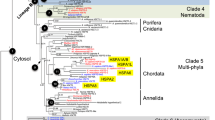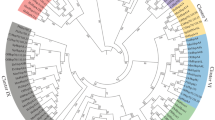Abstract
The 70-kDa heat-shock protein (HSP70) constitutes the most conserved protein present in all organisms that is known to date. Based on global alignment of HSP70 sequences from organisms representing all three domains, numerous sequence signatures that are specific for prokaryotic and eukaryotic homologs have been identified. HSP70s from the two archaebacterial species examined (viz., Halobacterium marismortui and Methanosarcina mazei) have been found to contain all eubacterial but no eukaryotic signature sequences. Based on several novel features of the HSP70 family of proteins (viz., presence of tandem repeats of a 9-amino-acid [a.a.] polypeptide sequence and structural similarity between the first and second quadrants of HSP70, homology of the N-terminal half of HSP70 to the bacterial MreB protein, presence of a conserved insert of 23–27 a.a. in all HSP70s except those from archaebacteria and gram-positive eubacteria) a model for the evolution of HSP70 gene from an early stage is proposed. The HSP70 homologs from archaebacteria and gram-positive bacteria lacking the insert in the N-terminal quadrants are indicated to be the ancestral form of the protein. Detailed phylogenetic analyses of HSP70 sequence data (viz., by bootstrap analyses, maximum parsimony, and maximum likelihood methods) provide evidence that archaebacteria are not monophyletic and show a close evolutionary linkage with the gram-positive eubacteria. These results do not support the traditional archaebacterial tree, where a close relationship between archaebacterial and eukaryotic homologs is observed. To explain the phylogenies based on HSP70 and other gene sequences, a model for the origin of eukaryotic cells involving fusion between archaebacteria and gram-negative eubacteria is proposed.
Similar content being viewed by others
References
Altschul SF (1991) Amino acid substitution matrices from an information theoretic perspective. J Mol Biol 219:555–565
Bork P, Sander C, Valencia A (1992) An ATPase domain common to prokaryotic cell cycle proteins, sugar kinases, actin and hsp70 heat shock proteins. Proc Natl Acad Sci USA 89:7290–7294
Cavalier-Smith T (1987) The origin of eukaryote and archaebacterial cells. Ann NY Acad Sci 503:17–71
Cedergren R, Gray MW, Abel Y, Sankoff D (1988) The evolutionary relationships among known life forms. J Mol Evol 38:98–112
Doi M, Wachi M, Ishino F, Tomioka S, Ito M, Sakagami Y, Suzuki A, Matsuhashi M (1988) Determinations of the DNA sequence of the mreB gene and of the gene products of the mre region that function in the formation of the rodshape of Escherichia coli cells. J Bacteriol 170:4619–4624
Felsenstein J (1985) Confidence limits of phylogenies: An approach using the bootstrap. Evolution 39:783–791
Felsenstein J (1991) PHYLIP manual, ver. 303. Herbarium. University of California, Berkeley
Flaherty KM, DeLuca-Flaherty C, McKay DB (1990) Three-dimensional structure of the ATPase fragment of a 79 K heat shock cognate protein. Nature 346:623–628
Galley KA, Singh B, Gupta RS (1992) Cloning of HSP70 gene from Clostridium perfringens using a general polymerase chain reaction based approach. Biochim Biophys Acta 1130: 203–208
Gething MJ, Sambrook JP (1992) Protein folding in the cell. Nature 355:33–45
Gogarten JP, Kibak H, Dittrich P, Taiz I, Bowman EJ, Bowman BJ, Manolson MF, Poole RJ, Date T, Oshima T, Konishi J, Denda K, Yoshida M (1989) Evolution of the vacuolar H+-ATPases: Implications for the origin of eukaryotes. Proc Natl Acad Sci USA 86:6661–6665
Gray MW (1989) The evolutionary origin of organelles. Trends Genet 5:294–299
Gray MW, Doolittle WF (1982) Has the endosymbiont hypothesis been proven? Microbiol Rev 46:1–42
Gupta RS, Picketts DJ, Ahmad S (1989) A novel ubiquitous protein “chaperonin” supports the endosymbiotic origin of mitochondrion and plant chloroplast. Biochem Biophys Res Commun 163:780–787
Gupta RS, Singh B (1992) Cloning of HSP70 gene from Halobacterium marismortui: Relatedness of archaebacterial HSP70 to its eubacterial homolog and a model for the evolution of the HSP70 gene. J Bacteriol 174:4594–4605
Higgins DG, Sharp PM (1988) CLUSTAL: a package for performing multiple sequence alignments on a microcomputer. Gene 73:237–244
Iwabe N, Kuma K, Hasegawa M, Osawa S, Miyata T (1989) Evolutionary relationship of archaebacteria, eubacterial and eukaryotes inferred from phylogenetic trees of duplicated genes. Proc Natl Acad Sci USA 86:9355–9359
Kasting JF (1993) Earth's early atmosphere. Science 259:920–926
Kishino H, Miyata T, Hasegawa H (1990) Maximum likelihood inference of protein phylogeny and the origin of chloroplasts. J Mol Evol 30:151–160
Lake JA (1991) Tracing origins with molecular sequences: metazoan and eukaryotic beginnings. Trends Biochem Sci 16:46–50
Lake JA (1988) Origin of eukaryotic nucleus determined by rate-invariant analysis of rRNA sequences. Nature 331:184–186
Lindquist S, Craig EA (1988) The heat shock proteins. Annu Rev Genet 22:631–677
Matthews CN (1971) The origin of proteins: Heteropolypeptides from hydrogen cyanide and water. In: Buvet R, Ponnamperuma C (eds) Chemical evolution and the origin of life. North Holland, Amsterdam, pp 231–235
Mayr E (1990) A natural system of organisms. Nature 348:491
Morimoto RI, Tissières A, Georgopoulos C (1990) The stress response, function of the proteins, and perspectives. Stress Proteins Bio Med 1:1–35
Pearson WR (1990) Rapid and sensitive sequence comparison with FASTP and FASTA. Methods Enzymol 183:63–98
Pesole G, Bozzeti MP, Lanave C, Preparata G, Saccone C (1991) Glutamine synthetase gene evolution: A good molecular clock. Proc Natl Acad Sci USA 88:522–526
Pühler G, Leffersy H, Gropp F, Palm P, Klenk H-P, Lottspeich F, Garrett RA, Zillig W (1989) Archaebacterial DNA-dependent RNA polymerases testify to the evolution of the eukaryotic nuclear genome. Proc Natl Acad Sci USA 86: 4569–4573
Rivera MC, Lake JA (1992) Evidence that eukaryotes and eocyte prokaryotes are immediate relatives. Science 257:74–76
Saitou N, Nei M (1987) The neighbor joining method: A new method of reconstructing phylogenetic trees. Mol Biol Evol 4:406–425
Schwartz RM, Dayhoff MO (1978) Origins of prokaryotes, eukaryotes, mitochondria and chloroplasts. A perspective is derived from protein and nucleic acid sequence data. Science 199:395–403
Smith MW, Feng D-F, Doolittle RF (1992) Evolution by acquisition: the case for horizontal gene transfer. Trends Biochem Sci 17:489–493
Sogin ML (1991) Early evolution and the origin of eukaryotes. Curr Opinion Genet Dev 1:457–463
Stanier RY, Ingraham JL, Wheelis ML, Painter PR (1987) The archaebacteria. In: General microbiology, 5th ed. Macmillan, London, pp 330–343
Woese CR (1987) Bacterial evolution. Microbiol Reviews 51:221–271
Woese CR, Kandler O, Wheelis ML (1990) Towards a natural system of organisms: Proposal for the domains archaea, bacteria, and eucarya. Proc Natl Acad Sci USA 87:4576–4579
Zillig W (1991) Comparative biochemistry of Archae and Bacteria. Curr Opinion Genet Dev 1:544–551
Author information
Authors and Affiliations
Additional information
Correspondence to: R. S. Gupta
Rights and permissions
About this article
Cite this article
Gupta, R.S., Golding, G.B. Evolution of HSP70 gene and its implications regarding relationships between archaebacteria, eubacteria, and eukaryotes. J Mol Evol 37, 573–582 (1993). https://doi.org/10.1007/BF00182743
Received:
Accepted:
Issue Date:
DOI: https://doi.org/10.1007/BF00182743




